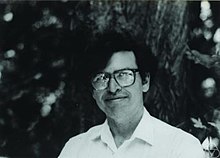William Thurston
Appearance

William Paul Thurston (October 30, 1946 - August 21, 2012) was an American mathematician. He was a pioneer in the field of low-dimensional topology. In 1982, he was awarded the Fields Medal for his contributions to the study of 3-manifolds. From 2003 until his death he was a professor of mathematics and computer science at Cornell University.
Quotes
[edit]- Mathematics is a process of staring hard enough with enough perseverence at at the fog of muddle and confusion to eventually break through to improved clarity. I'm happy when I can admit, at least to myself, that my thinking is muddled, and I try to overcome the embarrassment that I might reveal ignorance or confusion.
Over the years, this has helped me develop clarity in some things, but I remain muddled in many others.
Foreword to Teichmüller Theory
[edit](Foreword by William Thurston to Teichmüller Theory and Applications, Volume 1, John H. Hubbard, Matrix Editions, 2006)
- Mathematics is primarily a tool for human thought.
- The most important thing about mathematics is how it resides in the human brain.
- People can be fooled into thinking of mathematics as logical, formal, symbolic reasoning. But this is far from reality...computers are far better at formal computation and formal reasoning, but humans are far better mathematicians.
- When mathematics is explained, formalized and written down, there is a strong tendency to favor symbolic modes of thought at the expense of everything else, because symbols are easier to write and more standardized than other modes of reasoning. But when mathematics loses its connection to our minds, it dissolves into a haze.
- The term `geometry'...refers to a pattern of processing within our brains related to our spatial and visual senses, more than it refers to a separate content area of mathematics.
- I was really amazed by my first encounters with serious mathematics textbooks...I could appreciate that the mathematics was an impressive intellectual edifice, and I could follow the steps of proofs. I assumed that such an elaborate buildup must be leading to a fantastic denouement, which I eagerly awaited -- and waited, and waited. It was only much later, after much of the mathematics I had studied had come alive for me that I came to appreciate how ineffective and denatured the standard ((definition theorem proof)n remark)m style is for communicating mathematics. When I reread some of these early texts, I was stunned by how well their formalism and indirection hid the motivation, the intuition and the multiple ways to think about their subjects: they were unwelcoming to the full human mind.

